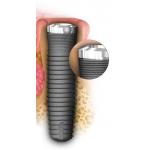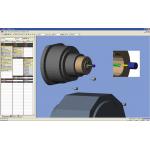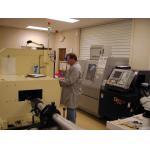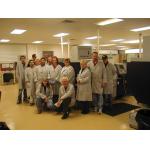Latest News
August 1, 2006
By Marvin Saucer
The intricacy, close tolerances, and small size of dental implants represent a complex CNC (computerized numerical control) machining challenge. Historically, programmers at IMTEC Swiss Mfg., a wholly owned manufacturing division of dental specialty products manufacturer/marketer IMTEC Corp., would spend three or four days writing G-Code for our Marubeni Citizen-Cincom Swiss CNC machines. Then, we’d spend another day or two on the machine just troubleshooting the program.
IMTEC Swiss recently switched to ESPRIT CNC programming software developed by DP Technology. The new software uses solid modeling to automate the geometry definition process, and its simulations of machining operations in action enables programmers to correct problems quickly as well as optimize the process. ESPRIT has taken the drudgery out of CNC programming and has cut the time needed to write and set up a typical program from days to less than a day.
Challenges of Machining Implants
A typical dental implant has a custom thread form on the outside diameter ranging from 3mm to 5mm diameter, a milled external or internal hexagon on one end, and either a M2 or 0-80 threads on the inside diameter. The custom thread, which resembles a buttress design, is specially designed to engage the implant to the patient’s bone without placing undue stress on the surrounding bone. Most of the features of the implant must be held to a tolerance of 60.002 inches.
|
|
| Image copyright 2006 and courtesy of IMTEC. |
< < An ENDURE implant from IMTEC.
Swiss-turn machines customarily used to produce the implants are challenging to program because they have two spindles and nine different types of milling capabilities. Consequently, programming a single part actually requires you to write three CNC programs that run simultaneously and control the motion of the machine’s 13 axes. These programs are linked together by codes that coordinate the motion of the multiple axes.
In the past, IMTEC Swiss used manual programming methods to achieve this end. They wrote variable programs in the G-Code language, and modified them by hand to fit individual parts.
The dental implant is so complex that it took at least two days to program a typical part using this method. It then took another day, at a minimum, to troubleshoot the part on the machine.
|
|
| Image copyright 2006 and courtesy of IMTEC. |
> > This ESPRIT screen capture from IMTEC shows the ENDURE implant to be parted off from the main spindle. This simulation does not show the sub-spindle synchronizing with the main spindle.
Synchronizing the different operations that were performed at the same time was the biggest challenge for the programmers. If we wanted to move operations around to improve the efficiency of the program, then we had to go back and rewrite the program. The difficulty of coordinating the various spindles and tools meant that we usually had a fairly significant amount of wasted time when either a spindle or a turret sat idle while the other continued to work.
Switch to New Software
IMTEC Swiss then purchased ESPRIT CNC programming software from DP Technology through MTTS Inc., a local Arlington, TX, distributor.
“I met Danny Greer with MTTS in the late eighties and have utilized his company ever since,” said Stephen Hadwin, executive vice president of IMTEC Corp. “Danny told me that ESPRIT was the solution for our Swiss-turn programming, and so far he has been right.”
When I joined the company one of my first objectives was to move to a graphical programming environment. What I really like about ESPRIT is that I can take a solid model from SolidWorks, import it into ESPRIT, and I am ready to start applying toolpaths to the different features of the part without having to calculate a single coordinate. Support engineers from DP Technology and MTTS provided a considerable amount of help in getting us up and running. Within a month or two, we had substantially reduced our programming time and reduced the time required to troubleshoot programs on the machine tool as well.
|
|
| Image copyright 2006 and courtesy of IMTEC. |
< < An ESPRIT screen capture from IMTEC depicts an interior diameter threading operation using the turret and sub-spindle.
Once IMTEC programmers import the part geometry, ESPRIT uses knowledge-based machining methods to automatically organize the geometry into features that normally correspond to machining operations, such as pockets, islands, bosses, and grooves. ESPRIT arranges the features into a tree that includes the machining operations needed to produce them. The programmer then reviews the feature tree and, in some cases, may create, modify, or re-order features manually.
I developed a tool library consisting of all the tools used by the company and processes that match a tool with a machining operation, including cutting speed, feed rate, depth of cut, etc. Many of these operations have been optimized to maximize machining productivity. Once the programmer has finished the job of creating and editing the work plan, ESPRIT automatically generates code for the machine tool that will be used to produce the part.
Balancing Operations to Reduce Dead Time
The next step is to balance the operations on the spindles and turrets to reduce dead time and maximize productivity.
IMTEC programmers typically begin this step by assigning operations based on their experience and intuition. They add synch points that link operations on different turrets, which causes them to be performed at the same time. The programmers then begin simulating machining operation on the computer screen, showing the machine, spindles, and turrets in action.
The simulation helps the programmers identify opportunities for improving productivity and quality. For example, they might switch operations around so that the machine time on the upper and lower turret will balance out in cycle time. Or they might move an operation from one spindle to another to eliminate dead time.
|
|
| Image copyright 2006 and courtesy of IMTEC. |
> > An ESPRIT screen capture from IMTEC shows a simulation of the tools and locations of tools to manufacture the ENDURE implant system in a 13-axes Swiss-turn machining center. This implant is machined complete without any secondary machining operations.
One of the biggest advantages of ESPRIT is the way it lets us validate the program on a computer screen rather than tying up a much more expensive machine tool. Our parts are so small that it’s very difficult to get the cutter compensation right when programming with G-Codes. For example, in some cases where you use a G41 or G42 command, the machine controller will generate more line segments than the machine could handle. Or, the programmer might accidentally send a tool with a 0.008-inch tool nose radius into a 0.004-inch radius corner.
These types of mistakes can take a considerable amount of expensive machine time to diagnose and correct. With ESPRIT, we can find these problems in the simulation. This helps explain why nearly every part that we program works perfectly the first time we run it on the machine.
Reducing Programming and Setup Time
IMTEC can now program an average part in four hours with another few hours setting up the machine with the correct tooling for the new part, running the first part, and then performing a detailed inspection. We inspect the part using 3D noncontact measuring systems and then compare the measurements to the solid model drawing that expresses the design intent. This is necessary because our average tolerance is 60.001 inch. We rarely find a problem with the first part because importing the solid model into ESPRIT ensures our geometry is correct, and we catch any tooling mistakes when we run the simulation.
Working with the DP Technology support representative, IMTEC has also taken advantage of ESPRIT’s Visual Basic (VB) programming interface to develop macros that automate the process of programming ID (inside diameter) broaching operations. This is a very challenging operation to program because the tolerance of our ID broaching operations is typically 60.0005 inches.
|
|
| Image copyright 2006 and courtesy of IMTEC. |
< < The author performing a CNC program verification at a machine.
ESPRIT simplifies the job by asking the programmer for the ID, the number of flats to be machined, if the ID is tapered, the size of the broach, and whether a six-sided or one-sided broach will be used. The macro then generates the code needed for the broaching operation.
Broaching operations prior to the VB macro would take about 30 minutes to program by hand with G-Codes. With the ESPRIT macro, it only takes a minute or two.
“The implant business has changed considerably in the last few years,” Hadwin concluded. “Our company has stayed ahead of our competitors by developing innovative implant designs that are more effective and durable. The challenge is that these new shapes are more complicated and difficult to manufacture. Our switch to new CNC software has helped us quickly develop programs that consistently produce products with very high levels of quality.”
Marvin Saucer is a manufacturing engineer and CAD/CAM programmer for IMTEC Swiss in Ardmore, OK. Send your comments about this article through e-mail by clicking here. Please reference “CAM Displaces, September 2006” in your message.
The Skinny on IMTEC
IMTEC Swiss Mfg. is a wholly owned manufacturing division of dental specialty products manufacturer/marketer IMTEC Corp., which designs, develops, manufactures, and markets root-form endosseous dental implants; proprietary, pure polytetrafluorethylene (PTFE) membranes; resorbable membranes and tacks; Sendax MDI mini-dental implants; tissue and bone regeneration systems; surgical drills and instrumentation; and an extensive line of dental prosthetics and laboratory components.
|
|
| Image copyright 2006 and courtesy of IMTEC. |
> > Ron Floyd, production manager (bottom center), with the weekend shift #1 crew at the IMTEC Swiss CNC department.
IMTEC’s Chairman of the Board of Directors and Co-Founder Ronald A. Bulard D.D.S., is a board-certified implantologist who has designed many implant systems including the Hexed-Head dental implant system; the ACCESS curved bristle toothbrush; and the O-Ball concept of the Sendax MDI mini-dental implant system.—MS
Product Information
DP Technology Corp.
Camarillo, CA
IMTEC Swiss Mfg. Inc.
Ardmore, OK
Marubeni Citizen-Cincom, Inc.
Allendale, NJ
MTTS Inc.
Arlington, TX
SolidWorks Corp.
Concord, MA
Subscribe to our FREE magazine, FREE email newsletters or both!
Latest News
About the Author
DE’s editors contribute news and new product announcements to Digital Engineering.
Press releases may be sent to them via [email protected].












